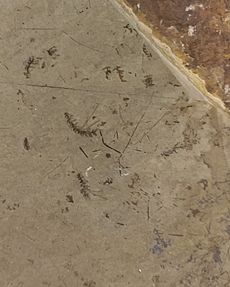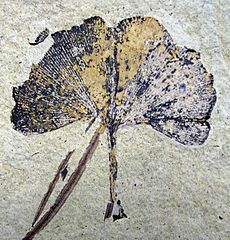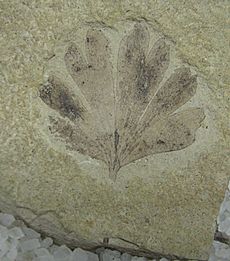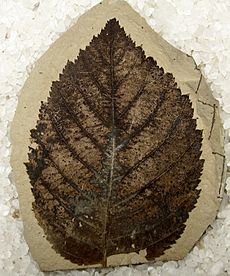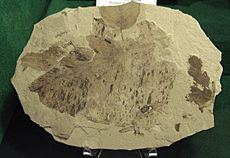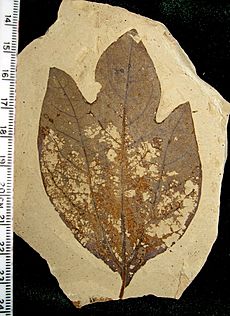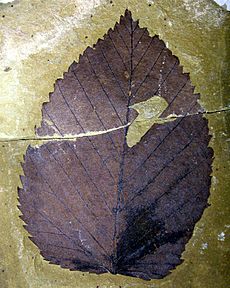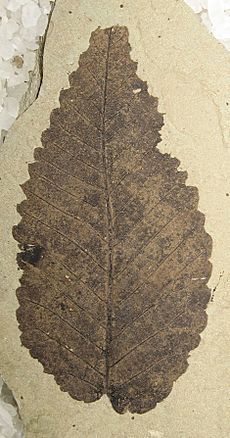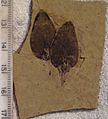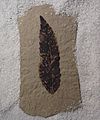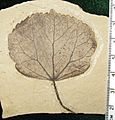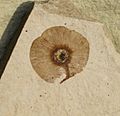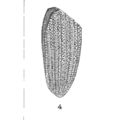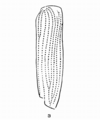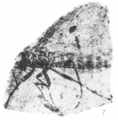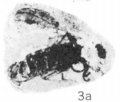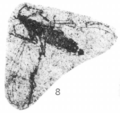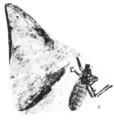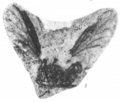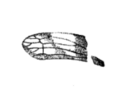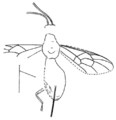Allenby Formation facts for kids
Quick facts for kids Allenby FormationStratigraphic range: Ypresian 52.5–48Ma |
|
|---|---|
| Type | Geological formation |
| Unit of | Princeton Group |
| Sub-units | Princeton Chert, Vermillion Bluffs Shale |
| Area | 300 km2 (120 sq mi) |
| Thickness | 1,860–2,100 m (6,100–6,890 ft) |
| Lithology | |
| Primary | Shale, sandstone |
| Other | Coal–breccia, coal–chert |
| Location | |
| Coordinates | 49°22.6′N 120°32.8′W / 49.3767°N 120.5467°W |
| Approximate paleocoordinates | 53°06′N 107°30′W / 53.1°N 107.5°W |
| Region | British Columbia |
| Country | |
| Extent | Princeton Basin |
| Type section | |
| Named for | Allenby, British Columbia |
| Named by | Shaw |
| Year defined | 1952 |
The Allenby Formation is a special layer of sedimentary rock found in British Columbia, Canada. It was formed a very long time ago, during a period called the Eocene (about 52.5 to 48 million years ago). This rock layer is made up of different types of rocks like shale and sandstone, and it also contains layers of coal.
What makes the Allenby Formation really cool is that it's packed with amazing fossils! Scientists have found many ancient insects, fish, and plants here. These fossils have been known since 1877, but the best ones come from a special type of rock called the Princeton Chert.
Contents
Discovering Ancient Life: Fossils in the Allenby Formation
The Allenby Formation is like a giant time capsule, preserving clues about life millions of years ago. Scientists have found many different kinds of fossils here, from towering trees to tiny insects. Let's explore some of the incredible ancient creatures and plants discovered in these rocks!
Ancient Trees and Plants
Imagine a forest from millions of years ago! The Allenby Formation has preserved many types of ancient trees and plants, including ancestors of trees we see today. These fossils help us understand what the environment was like back in the Eocene.
Conifers, Ferns, and Ginkgos
Here are some of the ancient trees and plants found in the Allenby Formation:
| Name | Family | Notes | Images |
|---|---|---|---|
|
Abies milleri |
This is the oldest true fir tree ever found! |
||
|
Salviniaceae |
An ancient mosquito fern, a small floating plant. |
||
|
Ginkgoaceae |
A fossil of the famous ginkgo tree, which still lives today! |
||
|
Ginkgoaceae |
Another type of ancient ginkgo tree. |
||
|
Metasequoia occidentalis |
A fossil of a dawn redwood, a tree once thought to be extinct. |
Flowering Plants
Many types of flowering plants, or angiosperms, have also been found. These include ancient versions of maples, alders, and even a relative of the golden-club.
| Name | Family | Notes | Images |
|---|---|---|---|
|
Acer rousei |
An ancient maple tree. |
||
|
Acer stewarti |
Another type of ancient maple. |
||
|
Acer stonebergae |
A third kind of ancient maple. |
||
|
Acer toradense |
A fourth type of ancient maple. |
||
|
Alnus parvifolia |
An ancient Alder tree. |
||
|
A fossil birch tree. |
|||
|
Fagopsis undulata |
An ancient beech tree. |
||
|
Neviusia dunthornei |
A type of ancient snow wreath plant. |
||
|
A fossil golden-club plant. |
|||
|
Palaeocarpinus stonebergae |
A plant related to birch trees. |
||
|
Sassafras hesperia |
An ancient sassafras tree. |
||
|
A plant related to the rose family. |
|||
|
Tetracentron hopkinsii |
Trochodendraceae |
A relative of the Tetracentron tree. |
|
|
Nyssaceae |
A relative of the dove-tree. |
||
|
An ancient elm tree. |
Ancient Animals
The Allenby Formation is also a treasure trove for animal fossils, especially insects and fish. These fossils give us a glimpse into the ancient animal life that once thrived in this region.
Insects and Fish
Here are some of the fascinating animal fossils discovered:
| Name | Family | Notes | Images |
|---|---|---|---|
|
Aphrophora sp. |
A type of ancient spittlebug. |
||
|
Bracon sp. |
A fossil braconid wasp. |
||
|
Cercopis grandescens |
Cercopidae |
An ancient froghopper. |
|
|
Cercopites torpescens |
Cercopidae |
Another type of ancient froghopper. |
|
|
Coelidia columbiana |
A fossil leafhopper. |
||
|
Cryptocephalites punctatus |
An ancient leaf beetle. |
||
|
Dawsonites veter |
Cercopidae |
A type of ancient froghopper. |
|
|
Dinokanaga wilsoni |
Dinopanorpidae |
An ancient scorpion fly. |
|
|
Elaterites sp. |
A fossil click beetle. |
||
|
Enchophora sp. |
Fulgoridae |
An ancient fulgorid plant hopper. |
|
|
Eomerope simpkinsae |
Eomeropidae |
Another type of ancient scorpionfly. |
|
|
Eriocampa tulameenensis |
Tenthredinidae |
A fossil sawfly. |
|
|
Libotonius blakeburnensis |
Libotoniidae |
An ancient percopsiform fish. |
|
|
Limonius impunctus |
A fossil click beetle. |
||
|
Palaeoptysma venosa |
An ancient spittlebug. |
||
|
Palaphrodes sp. |
Another type of ancient spittlebug. |
||
|
Palecphora sp. |
Cercopidae |
An ancient froghopper. |
|
|
Planophlebia gigantea |
A fossil water strider. |
||
|
Plecia canadensis |
Bibionidae |
An ancient marchfly. |
|
|
Plecia pictipennis |
Bibionidae |
Another ancient marchfly. |
|
|
Plecia pulchra |
Bibionidae |
A third type of ancient marchfly. |
|
|
Plecia reducta |
Bibionidae |
A fourth type of ancient marchfly. |
|
|
Plecia transitoria |
Bibionidae |
A fifth type of ancient marchfly. |
|
|
Plecia similkameena |
Bibionidae |
A sixth type of ancient marchfly. |
|
|
Pseudosiobla campbelli |
Tenthredinidae |
A fossil sawfly. |
|
|
Ptysmaphora fletcheri |
An ancient spittlebug. |
||
|
Ricaniella antiquata |
Polystoechotidae |
An ancient insect. |
|
|
Stenecphora punctulata |
Cercopidae |
An ancient froghopper. |
|
|
Stenolocris venosa |
Cercopidae |
Another ancient froghopper. |
|
|
Trogosus latidens |
Esthonychidae |
A fossil mammal from the group called tillodontia. |
See Also
- Princeton Chert
Images for kids



